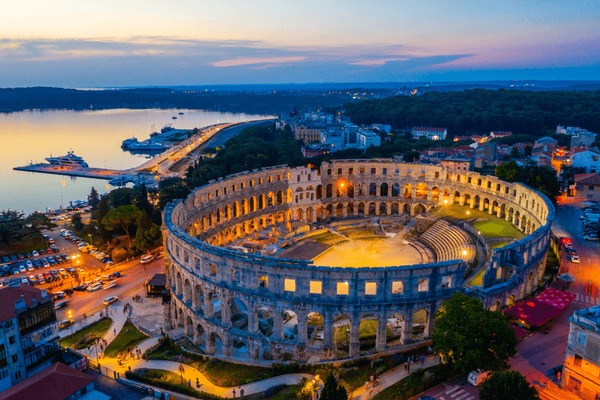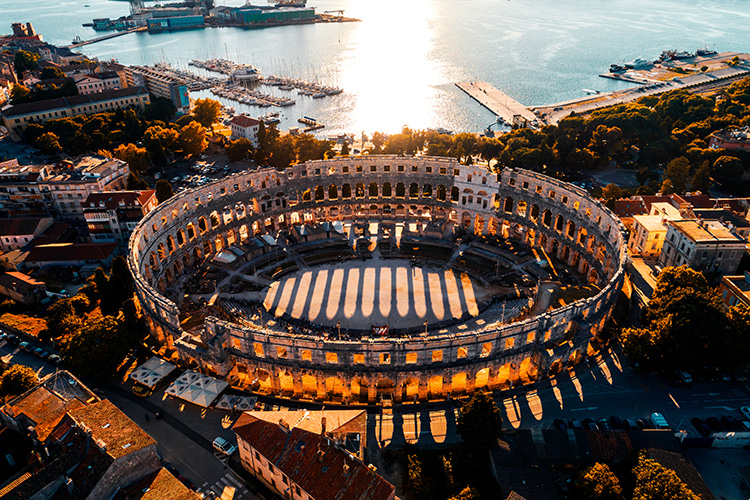The Pula Game – When legends met inside a 2000 year old Roman Amphitheatre :
Roman Amphitheatre “Anfiteatro de Pula” (Pula Arena), located in Pula, Croatia.
Pula arena is one of world’s six largest surviving arenas, constructed between 27 BC – 68 AD, it is the only remaining Roman Amphitheatre with four side towers preserved, and to this day remains in perfect condition, to such an extent that it lends itself to massive events.
For one day at least, Pula Arena, the only remaining Roman amphitheatre with four side towers and all three Roman architectural orders still intact, was converted into a football stadium. For the historic games between the two legendary teams, a 40m by 20m pitch was set up in Pula Arena. Arena, which once witnessed many bravehearts fight for survival, became a theatre for modern-day legends. The mini-tournament was a result of partnership between German giants Bayern Munich, who at the time was helmed by Croatian Niko Kovac and Istrian Tourist Board. Kovac, a former midfielder, captained Croatian national teams at 2006 FIFA World Cup and 2008 UEFA European Championship. As a player, Kovac won German Bundesliga with Bayern Munich and Austrian Bundesliga with Red Bull Salzburg. After retirement, Kovac guided Eintracht Frankfurt to a surprise DFB-Pokal triumph, in 2018, which convinced Bayern to rope him as their manager. In his first lone season with Bavarians as manager, former Croatia head coach guided them to Bundesliga-Pokal double.

The friendly tournament, lasting some three hours and featuring four matches, was witnessed by more than two thousand fans. It was won by Bayern 1990. In the first match, Bayern 1990 beat Bayern 2000 3-1 to enter the final. In the other semi-final, Team Srebric blanked Team Kranjcar 2-0. Bayern 1990, the oldest team, escaped with a 3-2 win in the final, while Bayern 2000 took the third-place honours. It was the first time that the amphitheatre had hosted a football match in its 2000-year history. The day’s programme, however, was not limited to football actions. According to http://istra.hr, “program was complemented with the battles of gladiators of ‘Spectacula Gladiatoria,’ that ancient Romans used to organize in amphitheatre.”

The Pula Arena has also previously hosted many other sporting and cultural events, including sell-out concerts, and not to forget the many gladiatorial combats. It also has an eponymous film festival. City of Pula, also spelled Pola, in itself is a wondrous place with its history dating back to pre-historic times. Located at the southern tip of Istrian peninsula, Pula is famed for wine, fishing, shipbuilding and tourism. It still boasts a multitude of ancient Roman buildings, of course, Pula Arena being most famous of them all.
In 2018, Croatia became smallest country to reach a FIFA World Cup final since Uruguay in 1950. A watch party was held inside Pula Arena to help residents of Istrian witness the making of history. Sadly, Croatia lost the match, against France. This was not the first time that Pula Arena was used to show a football match. The 2008, UEFA Championship quarter-final between Croatia and Turkey and 2014 FIFA World Cup opener between Croatia and Brazil were previously shown here.
#archaeohistories






